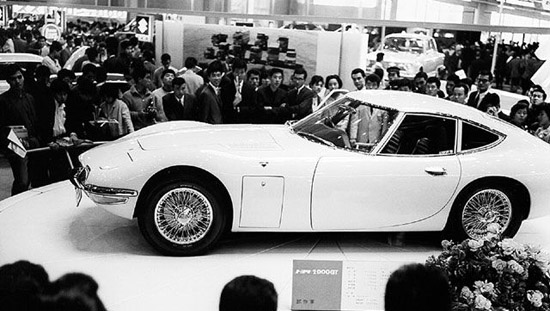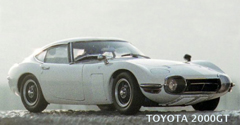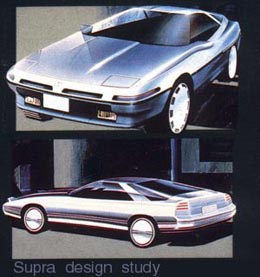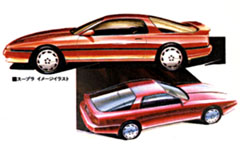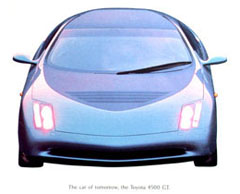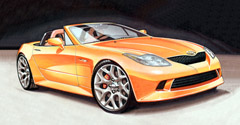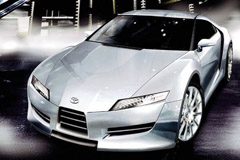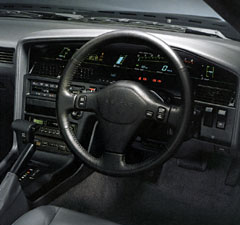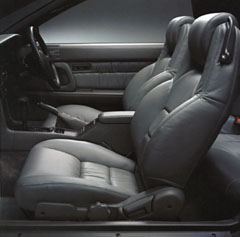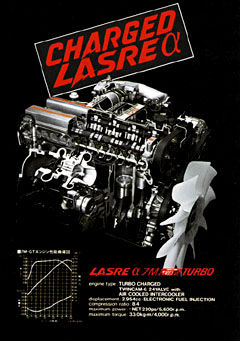| |
TOYOTA SUPRA TIMELINE
1979
- Celica Supra (1st gen.) introduced with 2.6L SOHC engine.
1981 - 2.8L SOHC engine introduced.
1982 - 2nd generation Supra, 2.8L DOHC engine.
1986 - 1986.5 3rd generation Supra introduced, 3.0L DOHC engine.
1987 - Supra Turbo introduced with 230 hp 245 lb/ft Turbo engine
1989 - Mid-line restyled 3rd generation Supra. Turbo version has 232 hp, 254 lb/ft torque.
1990 - Japan only - Supra gets a new 280 hp 2.5 liter twin turbocharged 1JZ-GTE engine.
1993 - 4th generation introduced
1996 - Six-speed manual transmission dropped due to emission regulations.
1997 - Return of the six-speed manual transmission.
1997 - Mid-line restyled 4th generation Supra, introduction of 15th Anniversary model.
1998 - VVT-i on non-turbo models added, no Turbos available with California emissions
1999 - Toyota Supra sales stop in the United States
2002 - Toyota Supra production stops
TOYOTA SUPRA HISTORY
Toyota Supra was a continuation of a 2000GT heritage presented years earlier. The first three generations of Supra were offered with a direct descendant to the 2000GT's M engine. Toyota introduced the Celica Supra (MA46) in 1979. Its styling was based upon the Celica liftback design, but it was both
longer and wider. However, it was the engine that made the Supra
stand apart from the Celica. The Supra's 4ME 2.6-liter inline-6
engine was the first Toyota production engine to be equipped with
electronic fuel injection. The Supra was available with both a manual
and automatic transmission, and came standard with 4-wheel-independent
suspension and 4-wheel disc brakes. Except for the addition of luxury
items such as optional leather seating and automatic climate-control,
the Supra remained unchanged until 1981. In that year, Supra (MA47)
was given a 5ME 2.8-liter single overhead cam engine, a revised
4-speed automatic transmission and final drive gearing, and was
optionally available with a new Sport Suspension package.
In 1982 a complete redesign of the Supra (MA61) happened again.
Now available as two distinct models, L-type and Performance, Supra
also received another engine upgrade. The new 5M-GE engine still
displaced 2.8 liters, but now sported double overhead cams. Both
the L-type and Performance package vehicles were mechanically identical,
with differences limited to fender flares, wider wheels and tires,
and a sport interior on the Performance package. Slight changes
on the 1984 models were limited to minor engine modifications on
the manual transmission-equipped vehicles (higher compression ratio
and larger diameter intake).
The next major change was 1986.5 when the 3rd generation Supra (MA70)
was finally given its own identity. No longer part of the Celica
line, the 1986.5 Supra was equipped with a 3.0 liter DOHC engine
and retained the four-wheel disc brakes and all-independent suspension
of its predecessors. In 1987, Supra (MA71) received a turbocharged
engine producing 230 horsepower and 245 lb/ft of torque. It was
the first Toyota model to be available with both a turbocharged
engine and anti-lock brakes. The 1987 Supras were available with
an optional targa-type removable Sport Roof for open-air driving.
The Turbo-A was Toyota's evolution model for Group A touring car championships all over the world which required a minimum of 500 which were only sold in Japan and was produced between August and September of 1988. Differences between the standard Supra and the Turbo-A model were both cosmetic and mechanical. The front nose features a cooling duct, the badging 'turboA' and a Black paint job (all 500 are black). The engine bay houses a 267 bhp 7M-GTEU. All Turbo-As also came standard with leather interior. Minor styling updates and equipment options happened 1989-1992,
power increased to 232 hp and 254 ft/lb, mainly due to intake manifold
redesign and ECU updates. The mkIII Supra was also available in two non-export models in Japan, the 2.0 L 210 hp twin-turbo 1G-GTE, and with a JZA70 with a 2.5 L 280 hp twin-turbo 1JZ-GTE, known as 2.5GT Twin Turbo (JZA70).
A special light weight version of the 1JZ-GTE equipped JZA70, the 2.5 Twin Turbo R, had black/grey Recaro seats, a Torsen differential, Bilstein suspension and upgraded springs, larger sway bars, Momo steering wheel and gear knob and matching interior trim. This was the fastest factory production version of the MK3 Supra, running a mid 14 second 1/4 mile.
The year 1993 was when next major change occurred, with the Supra
(JZA80) entering the category of "supercars." Available
in both Turbo and non-Turbo version, the new Supra was part of a
performance breed. Many weight saving measures were employed: Toyota
equipped the vehicle with hollow carpet fibers and made the rear
spoiler (optional on Turbo models) hollow. With 320-horsepower,
the vehicle was capable of 0-100 km/h runs in under 5 seconds, and
an electronically-limited top speed of 300 km/h. This was the highest
level of performance Toyota had ever placed in one vehicle. In 1997
Supras were sold as Limited Edition 15th Anniversary models after
receiving additional frame strengthening and sound-deadening material.
Due to the ever rising prices causing a decline in the high-performance
vehicle sales, Motomachi Plant in Toyota City, Japan, ceased the
production of Supras in 2002. You can still get low cost Toyota Supra OEM & aftermarket accessories for your car. You don't have to worry about outdated parts if your Supra needs repairs.
Is there ever going to be a fifth generation of the Supra? Various reports have been announcing the coming of a mkV Supra first in 2006, then in 2008 (predicted to be powered by a naturally aspirated 3.5 liter V-6 2GR-FSE from GS350 Lexus, all-aluminum powerplant and expected to produce 350bhp at 7000 rpm and about 290 lb-ft of torque at 5000, curb weight of about 3200 lb), and more recently the 2010 production year model rumored to come with the choice of a 450 hp V8 or a 3.7-liter 350hp V6 and pricing ranging from $40,000 to $50,000. For now we have to just wait and see...
As of August 2008 The Supra revival has been halted due to high mpg requirements, allowing Toyota to focus on its RWD coupe, jointly developed by Subaru. And then, there is still the Lexus LF-A car in the works...
TOYOTA
SUPRA MK3 TIMELINE
SHOW MK3 TIMELINE :: HIDE MK3 IMELINE
1986.5 Toyota Supra
The third generation Supra was introduced in 1986.5 as a free standing
model, officially separating it from the Celica. Whereas the Celica
became a front wheel drive sport coupe, the Supra retained its image
as a rear-wheel drive sports/GT car. The new Supra would continue
to move upscale and become a showcase for Toyota technology. Originally
slated as a 1986 model, production delays caused the model to actually
be introduced mid year (hence the 1986.5 designation). The all new
Supra was powered by a 3.0 liter DOHC inline six cylinder engine rated
at 200 bhp. Notable features included an electronically controlled
independent suspension (called the Toyota Electronic Modulated Suspension
- TEMS), and a removable Sport-Roof panel (Targa top).
Production: 33,283
Engines: 3.0 I6 200 bhp.
1987 Toyota Supra
The first Supra Turbo was introduced in 1987. The inter-cooled,
turbo charged version of the 3.0 liter inline 6 cylinder engine
boosted power to 230 bhp and 246 lb-ft. The Turbo model also included
an engine oil cooler and integrated rear spoiler. The sports package,
which was standard on the Turbo and optional on the base model,
included a limited slip differential (LSD), TEMS, and headlamp wahers.
A new Anti-Lock Braking System (ABS) was optional on both models.
Production: 29,907
Engines: 3.0 I6 200 bhp. 3.0 I6 Turbo 230 bhp, 246 lb-ft.
1988 Toyota Supra
Only minor changes were in store for the 1988 Supra. The base interior
was changed from vinyl to cloth. The engines received minor modifications
to improve quietness. And the Beige/Brown two-tone paint option
was droped.
Production: 19,596
Engines: 3.0 I6 200 bhp. 3.0 I6 Turbo 230 bhp, 246 lb-ft.
1989 Toyota Supra
The Supra received a freshening for 1989 with a new grille, air
dam, taillights, and rear spoiler. The Turbo engine was further
refined with intake, wastegate, and turbo modifications, good for
increases of 2 bhp and 8 lb-ft. Speed sensitive power steering was
added and the rear suspension rates were increased. The cruise control
moved to the steering wheel spokes.
Production: 14,544
Engines: 3.0 I6 200 bhp. 3.0 I6 Turbo 232 bhp, 254 lb-ft.
1990 Toyota Supra
Only minor changes were in store for 1990. A driver's side airbag
was made standard. The cruise control moved back to a column mounted
stalk. Fluid filled engine mounts were added for smoothness and
the power steering boost was trimmed for more feel at high speeds.
Production: 6,419
Engines: 3.0 I6 200 bhp. 3.0 I6 Turbo 232 bhp, 254 lb-ft.
1991 Toyota Supra
New five-spoke wheels with Goodyear GS-D Z-rated tires are made
standard, along with ABS on Turbo models. An out-sliding power sunroof
is made optional, the Sport Roof and pop-up sunroof are still available.
Production: 3,623
Engines: 3.0 I6 200 bhp. 3.0 I6 Turbo 232 bhp, 254 lb-ft.
1992 Toyota Supra
Year 1992 marked the last year of the third generation. The Automatic
transmission shift points were revised. A ten-speaker stereo system
with the ETR/Cassette/CD system was made optional.
Production: 1,193
Engines: 3.0 I6 200 bhp. 3.0 I6 Turbo 232 bhp, 254 lb-ft.
TOYOTA SUPRA MK4 TIMELINE
SHOW MK4 TIMELINE :: HIDE MK4 IMELINE
1993 Toyota Supra
The fourth generation Supra was introduced in 1993 and firmly
established the Supra as a true performance car. The standard engine
was a 3.0 liter I6 rated at 220 bhp - almost the same as the previous
generation's turbo charged engine. The Turbo model added twin-turbos
to produce a startling 320 bhp, the most powerful engine offered
in the U.S. by any volume import manufacturer at the time. The Supra
also featured new softly rounded styling and a more compact look
wrapped around a 2+2 body style (though only children or small pets
could ever fit in the back seat). The turbo model featured an optional,
and outrageously high, spoiler that almost reached the height of
the roof. Anti-lock brakes and dual air bags were standard on both
models. The Turbo model also featured standard traction control
and a 6-speed manual transmission.
Production: 2,901
Engines: 3.0 I6 220 bhp @ 5800 rpm, 210 lb-ft @ 4800 rpm. 3.0 I6
Turbo 320 bhp.
1994 Toyota Supra
The Supra was pretty much carryover for 1994.
Production: 3,422
Engines: 3.0 I6 220 bhp @ 5800 rpm, 210 lb-ft @ 4800 rpm. 3.0 I6
Turbo 320 bhp.
1995 Toyota Supra
To reverse the ever-increasing price of the Supra, Toyota introduced
the limited edition Supra SE, which was basically a standard model
stripped of all options. Little else was changed.
Production: 2,266
Engines: 3.0 I6 220 bhp @ 5800 rpm, 210 lb-ft @ 4800 rpm. 3.0 I6
Turbo 320 bhp.
1996 Toyota Supra
The big news was the elimination of the 6-speed manual transmission
from the Supra turbo. Toyota was not able to get certification for
the transmission in time to meet new on-board diagnostic system
requirements for emission controls.
Production: 852
Engines: 3.0 I6 220 bhp @ 5800 rpm, 210 lb-ft @ 4800 rpm. 3.0 I6
Turbo 320 bhp.
1997 Toyota Supra
The 6-speed transmission returned for the Turbo only. All Supra's
were designated 15th Anniversary Edition, even though technically,
it was the 18th edition (1979-1997). The big news was that Toyota
cut Supra prices across the board by about $10,000. Thus, a 6-speed
manual Supra Turbo cost just $39,900 while a Supra Turbo automatic
cost $50,400 just the year before.
Production: 1,379
Engines: 3.0 I6 220 bhp @ 5800 rpm, 210 lb-ft @ 4800 rpm. 3.0 I6
Turbo 320 bhp.
1998 Toyota Supra
The Supra underwent a few minor changes for 1998. The exterior
remained the same, except for the removal of the Anniversary emblems
on the front fenders. Inside, a new 3-spoke steering wheel replaced
the previous 4-spoke wheel, the cloth sport seats had a bolder design,
and the radio was redesigned. The Naturally Aspirated I6 got Variable
Valve Technology with Intelligence (VVT-i), which lead to an increase
of 5 bhp and 10 lb-ft over the year before. The Twin Turbo I6 remained
unchanged. The 5-speed manual transmission was dropped, even though
the 6-speed manual was still available only on the Twin Turbo. Therefore,
the base model was only available with an automatic. Faced with
declining sales for Japanese super cars, this would be the last
year that the Supra would be sold in the U.S.
Production: 1,232
Engines: 3.0 I6 225 bhp @ 6000 rpm, 220 lb-ft @ 4000 rpm. 3.0 I6
Turbo 320 bhp.
|
|
|
|
|
|
|
|
|

